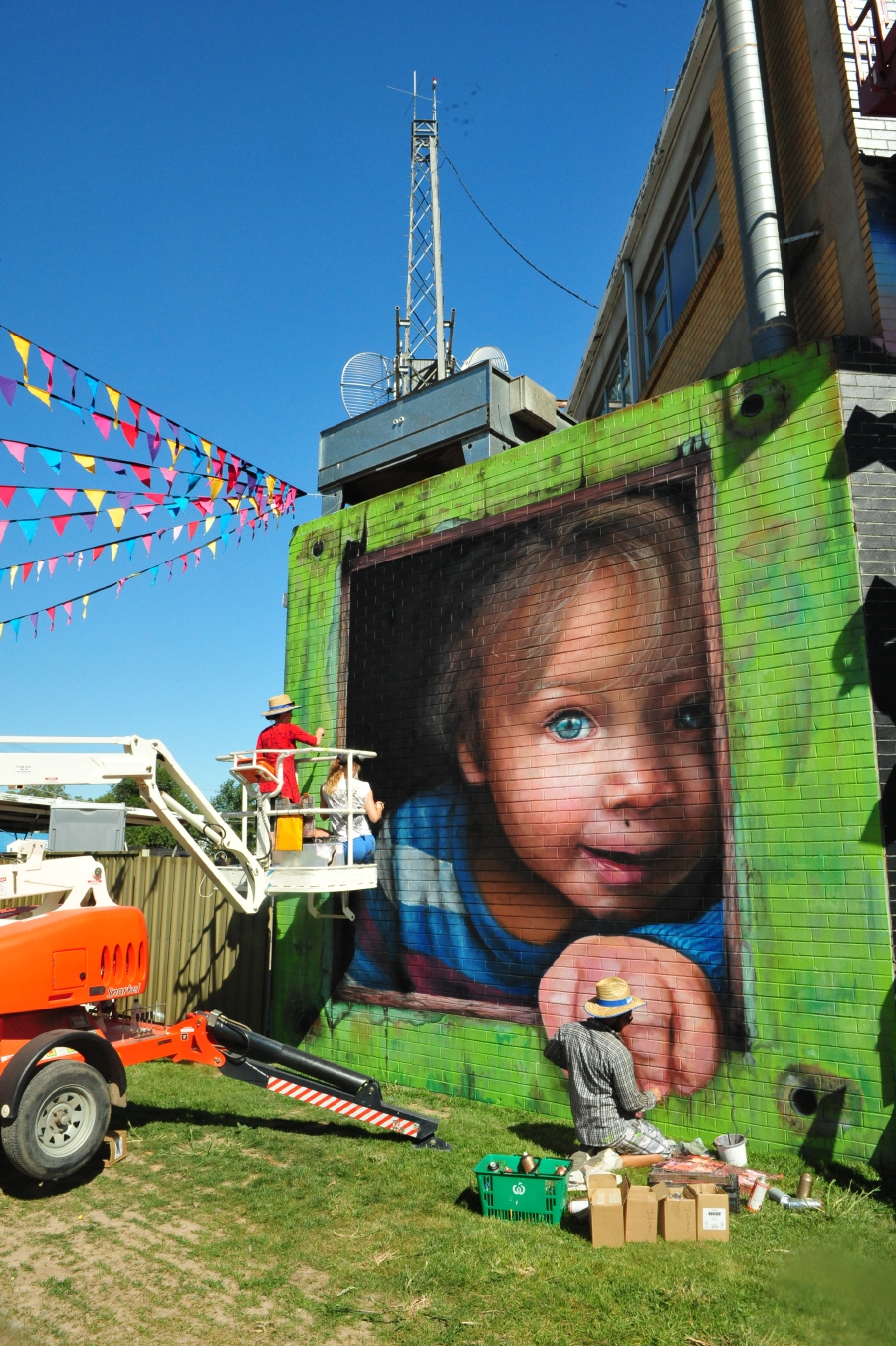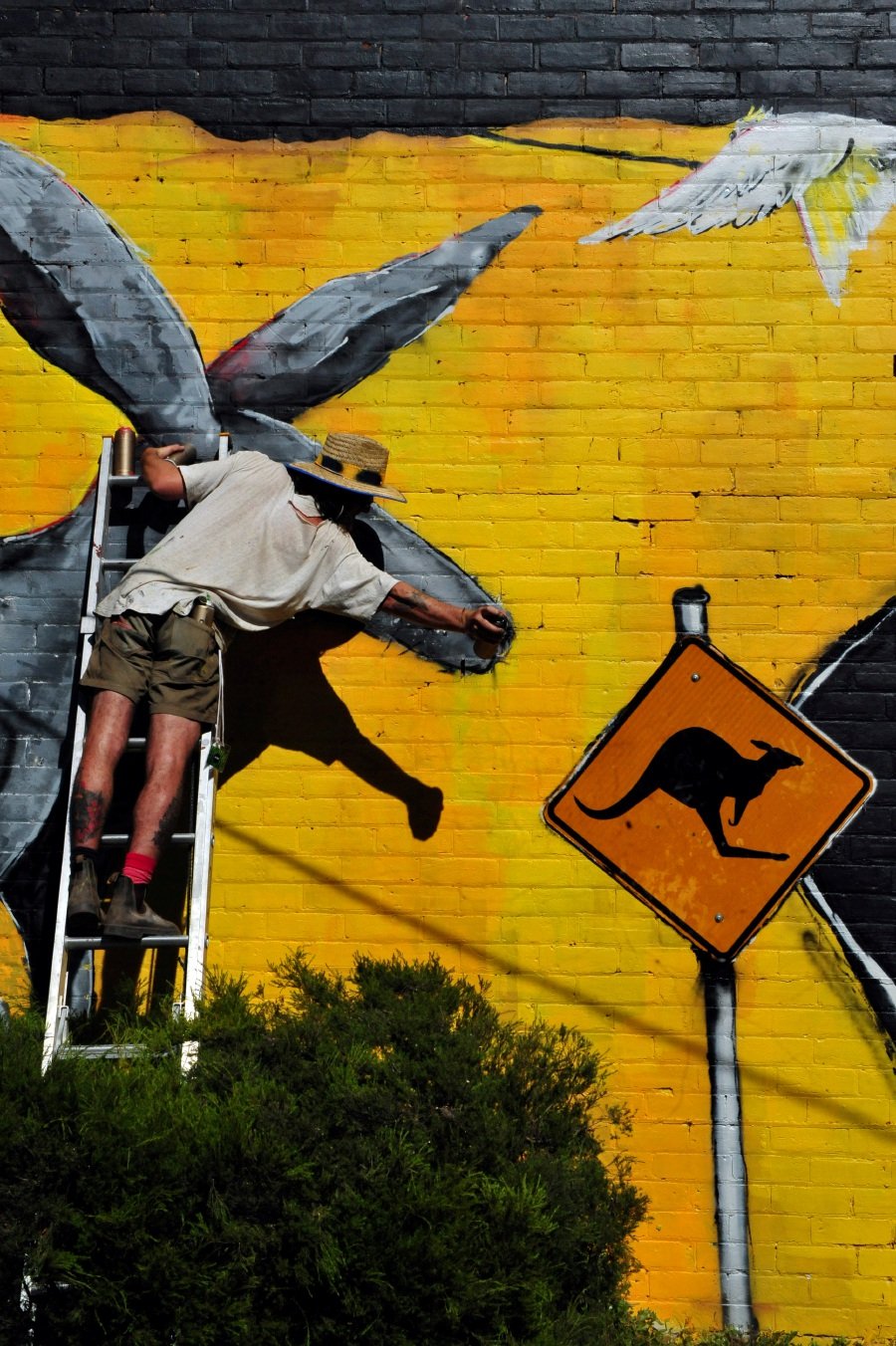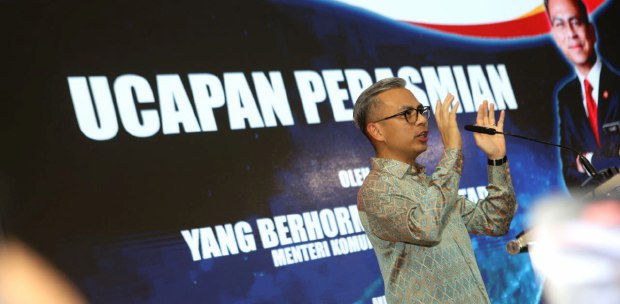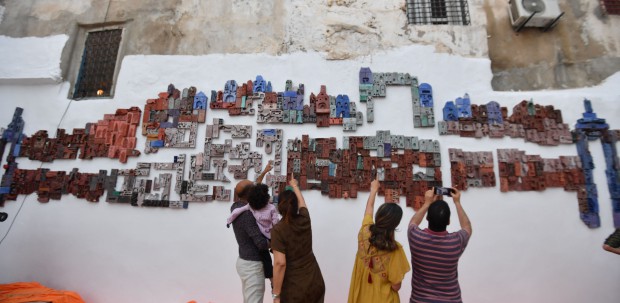The Benalla Wall to Wall Street Art Festival in Victoria highlights the important role that art plays for youth in the small city, writes Andrew Drummond Law
THE artist carefully balances on the ladder, wearing a straw hat and long-sleeved shirt to shield herself from the burning sun. A respirator mask protects her eyes and lungs from the noxious fumes as she spray-paints her colourful creation onto the wall.
Gloves protect her from the hot metal spray paint canisters sitting on the ladder‘s top step, waiting their turn to be used. Music plays in the background, giving a rhythm to her work and a distraction from the physically challenging conditions. It must be at least 36 degrees.
After a while she descends to ground level, takes off her mask and hat, and gulps down water, perspiration dripping off her forehead. Stepping back for better perspective, she takes in her mural.
Is she happy with her work? Not yet. She steps back up the ladder and carries on.

Her name is Elle, one of 21 mural artists at the Benalla Wall to Wall Street Art Festival in Victoria, Australia.
The creative and physical energy to complete the festival‘s murals is not for the faint of heart.
And that strength of character and artistic talent is how Malaysian artist Leonard Siaw won a mural competition in 2017 organised by Publika and the Visit Victoria tourism agency, with UEM Sunrise, in Malaysia. It landed him a slot to paint his own mural titled Fishing Fun at the festival.
Shaun Hossack, festival artistic director, and also founder and creative director of Juddy Roller, a Melbourne-based street art network and studio, walks me around. As we pass different artists, live bands, helpers and friends, he‘s greeted by “hang loose“ hand signals and friendly banter.

It is respect and admiration that is shown for Hossack, for he has clearly helped place the small city of Benalla on the map, providing a platform for many artists‘ work. With more than 14,000 inhabitants in this northeastern city of Victoria, Benalla is a 2.5-hour drive from Melbourne. It has hosted the festival for the past four years.
A 2017 survey estimated the local economy benefited from the 44,000 people visiting the festival last year by A$6 million (RM18 million).

But for Hossack it is about much more than economics. It is the social impact and the important role that art plays for the youth in this small conservative city that he cares deeply about.
Pushing the boundaries — like any true artist — has got him, and Benalla, in the forefront of the Australian mural art movement. Dealing with local government, maintaining the world-class creative input, fundraising, and marketing the event, are no mean feat to achieve. Now that truly is an art. Hat tip to Mister Hossack.
A brush with a ‘maniac’

Malaysian street artist Leonard Siaw talked to Andrew Drummond Law during the recent Benalla Wall to Wall Street Art Festival in Victoria, Australia
WHAT DO YOU DO?
Capture amazing things with brushes.
WHAT DOES YOUR ART MEAN TO YOU?
It gives me a reason to explore, meet people and tell stories.
WHAT IS THE TITLE OF YOUR MURAL AND ITS STORY?
It‘s called Fishing Fun and one of my best memories. I spent most of my childhood in the countryside, where my grandparents lived. There‘s a lake in front of their house, where my grandparents and uncle used to run a fish farming business. During the harvest season, everyone would jump into the lake, catch fish and have lots of fun.
Benalla is in the countryside too, so somehow it interrelates. I came up with the concept because it clicks, being specially designed for that particular wall, as arranged by Benalla Local Council and Juddy Roller (a street art network).
I tell my story through my mural art, spreading some joy around Benalla city. One of the local old folk said she felt like the child in the painting was somehow talking to her. Well that‘s good to know. it‘s meant to interact with people.
VIEWS ON AUSTRALIAN STREET ART? WHAT DID YOU LEARN FROM OTHER ARTISTS AND WHAT DID THEY LEARN FROM YOU?
It is more professional, more beautiful — there‘s more artistic freedom. The local communities are more appreciative of art in general, and more likely to possess a better understanding of art as a culture. Their determination, creativity and skills in the final artistic touches.
Their techniques for producing art murals.? The majority of the artists are focused on portrait and still art. Their techniques are varied and very different from the way Asians project art.
I hope my art serves as an example to remind the artist of where or why they began their passion for art, because art, in general as a practice, is a human culture in itself that should not die.
WHAT MAKES YOUR ART UNIQUE?
There is an obvious hint of the exotic in my artwork as a Southeast Asian that a majority of them (other artists) view as uncommon and unique, outside of their local Australian culture.
WHAT CAN THE MALAYSIAN ART SCENE LEARN FROM AUSTRALIA?
I believe Malaysians can benefit from their open-mindedness in every aspect of life and break free from the Asian stereotype that we suffer within our Malaysian society. We need to increase our exposure beyond international borders, if we are to grow our artistic perspective. Street art isn‘t something friends or parents encourage their children to do.
I received a mix of negative and positive feedback. Negative feedback like asking me to get a proper office job, or quit painting and so on, because art can only be a hobby. My parents didn‘t give many words of encouragement, but they are proud of what I‘m doing. My friends pay more attention to me when I produce results.
There‘s still a great lack of federal support in helping Malaysian art grow as culture, because our local art scene is still greatly dependent on aspects of tourism, and not as a social value. So our collective local practices in art are still considered a niche - uncommon and unremarkable by global standards.
WHAT COULD HAVE BEEN DONE DIFFERENTLY AT THE FESTIVAL?
More time for the artists involved to mingle, socialise and share their artistic ideals.
ADVICE FOR OTHERS WANTING TO SUCCEED IN THEIR ART?
People‘s opinions don‘t define you. All you need to do is keep moving forward, keep producing artwork. Maintain the flame and eventually you will get there. And when you arrive there, set a bigger goal. Art is like a borderless desert and lifelong journey.
THE BEST AND WORSE ASPECTS OF YOUR ART?
The best part is you get to enjoy life by doing what you love. The worst is you need to protect yourself from harmful toxic chemicals in the paint or aerosol spray paint, which is extremely dangerous for your eyes and lungs.
YOUR BIGGEST PROFESSIONAL CHALLENGE?
To carry on smiling in the face of all the negative people who will try to knock you down with their nasty feedback. Yes, it hurts for sure. But handling my emotions is a huge challenge for me. I‘m a short-tempered person.
IF YOU WERE NOT AN ARTIST, WHAT WOULD YOU BE?
I have no idea. I was born to be an artist. If I could travel back in time, I would still choose to be an artist.
WHICH ART ARE YOU ARE MOST PROUD OF?
The mural I did for the Wall-to-Wall Festival in Benalla because it exposed to the public, the people, the story I‘m telling through my artwork. It was also the first time I was free to paint what I wanted to paint.
WHAT BRINGS ABOUT YOUR CREATIVITY?
I listen to music, watch movies or watch motivational videos. Besides that, I also need to understand my clients‘ need and provide a solution for them. Once I get to understand what they want, the drafting and final stages shouldn‘t be an issue.
TELL ME ABOUT YOUR BACKGROUND.
I admire those kids who are able to attend art class from a young age. I didn‘t get to attend when I was young, and back then my parents didn‘t encourage me to study art. I was sent for tuition in every subject — except art. So I secretly practised drawings in my exercise books, during my school and tuition classes.
WHAT IS INTEGRAL TO THE WORK OF AN ARTIST?
The message or story that an artist is trying to express. Sometimes a painting says a lot about the artist. It is their unique style and personality that is expressed in their artwork.
WHAT ROLE DOES AN ARTIST PLAY WITHIN SOCIETY?
Art is my personal channel to speak to society, because most artists are inherently introverts.
WHAT PROJECTS ARE YOU WORKING ON? AND WHAT WAS YOUR FIRST COMMISSION?
I‘m working with a car dealer in Kuching. They have a mural painting request. The first commission was an A4 black and white portrait I did during a university roadshow in a shopping mall.
WHICH ART ELEMENT DO YOU ENJOY WORKING WITH THE MOST?
My artwork incorporates the effects of impact, and freezes moments through my brushes. Apart from that, I approach my artwork with a realistic style infused with optical illusion. My creations also emphasise the interaction between the viewer and the artwork. This adds a different kind of sensation and engagement.
Apart from that, I can be telling a story and sharing moments through a mural or street art. So it‘s more than just street art.
HOW DID YOU START MAKING ART? AND WHAT‘S YOUR INSPIRATION?
I realised that drawing is an alternative way to express and communicate. My inspiration comes from my childhood, or something that I need to share to create awareness. I do have a muse. I‘m an overthinking person.
STRANGEST ART YOU HAVE SEEN?
The weirdest art I have ever seen was an ongoing piece in Balai Seni in Kuala Lumpur. I forget how it looked, but it caught my attention because it was performed by a repetitive machine, instead of an artist.
ART WORLD LIKES AND DISLIKES?
I enjoy the stories and style expressed by different artists. I dislike and I‘m disappointed by the ignorance portrayed by society and the way they judge art, based on shallow opinions and prejudices.
FAST FACTS

LEONARD SIAW
Kuching, Sarawak
EMAIL [email protected]
INSTAGRAM @siawtistic
FACEBOOK www.facebook.com/siawtistic
Born: Kuching in 1987
Languages: Mandarin, Hokkien, Hakka, English, Bahasa Malaysia
Horoscope: Scorpio/Fire Rabbit.
Profession: Mural artist and designer.
First job: Graphic designer at a printing and design firm
Ambition: Transform and beautify cities while travelling the world
Favourite colour? Black, grey and white
Last book read: Dean Sunshine‘s Street Art Now: Melbourne Australia and Beyond, 2012-2014.
Favourite living artists: Rone, Matt Adnate, Smug
Current tune: All The Stars by Kendrick Lamar and SZA
Hobbies: Drawing, painting, capoeira, breakdancing
Beach or City? Beach
Fave holiday destination: Somewhere for jungle trekking or hiking; avoid the city‘s polluting noise and air; get close to nature, while working out
Fave Kuching food? Kolo Mee, Laksa
Fun Fact: “Siaw“ in Hokkien means “maniac“. A classmate frequently called me Siaw. When I drew something they liked they would say: “You‘re really siaw!“





